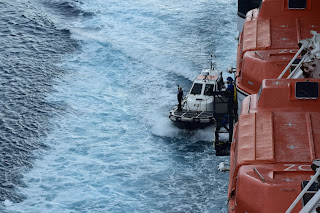Our first close up of Italy was through the Straights
of Messina the very narrow strip of sea between Italy’s toe and Sicily. They
have been threatening a bridge between the two much to the chagrin of the ferry
operators. Mind you the power cables have all been moved subsea but improving
the landscape was clearly not a driver as the old 1954 cable towers are now
heritage listed. (Isn’t engineering beautiful?)
I know many of you will be wanting to know where our
cabin is. It is on the starboard side (right for you landlubbers) on the
foremost kink on the 8th level which is the same as the bridge. The
kink gives us a bigger balcony (plenty of cocktail room for five) as well as a
larger state room (no cabins here).
Italy
is proud of its higher risk nautical profile with the pilot happily jumping off
ship at 12+ knots rather than the usual 6 knots used in other countries. (It
helps to explain Concordia and why we like the Queens!)
What
was interesting was the old fashion manoeuvring of tugs when you have a ship
steered only by rudder and no bow thrusters. These tugs worked very hard to
moor this tanker around QV and then reversing into her berth.
Salerno
was a working port with rolls of steel and aluminium ingots occupying much of
our berth. In town however there were some wonderful old churches. This is St
Benedict.
Pigeons
as with many countries are a nuisance and despite the numerous spikes still
managed a foothold on these arcade lights. It’s almost a two finger act.
The
Church of the Annunciation had a wonderful tiled roof which looked good against
the backdrop of the Etrusco Sammitica Acropoli.
As
we left Salerno with a jug of Pimms on the rear deck a storm brewed with much
lightening striking the nearby hills. One strike started a fire.
However,
to the South the smoke from this “hill’ was not from a fire but the menace of a
potential eruption of the Vesuvius volcano.
It
was all a bit distracting as the captain was trying to reverse, turn 180
degrees so we faced the right way and then travel through two more 90 degree
turns to get out of the harbour.
Our
second port was Citivichia (sometimes called the port of Rome albeit the latter
is 50 miles away). It was a lovely Italian seaport. The treatment of heritage
buildings in this part of the world has some pluses and minuses. Here one of
the historic gates is hard against a recent block of flats.
While
this gate tower has been extended to include flats with the usual drying
facilities.
The
market was very colourful set up amongst trees with shade cloth added for extra
shade. There were some characters here which reminded me of the mafia whose
foothold in Melbourne is at the fruit markets.
Not
that they were all members…
The
port is huge with a large seaward wall accommodating several cruise ships.
The
following day saw us in Livorno which has a famous statue of four Moors. It
reflects the port and also the Duke of Tuscany’s success over the pirates that
used to roam over the Mediterranean. The Moors are significantly larger than
life and were quite a challenge of Bronze casting given its 1638 construction.
Livorno
also has a Venetian quarter with many canals designed by Venetian engineers.
At
the centre of the canals is the Fortezza Nouva (completed in 1605)
The main square is unusually large and would have
been able to hold huge crowds and events in its past however, it looked almost
abandoned when we visited. There is a tunnel under the square that forms part
of the canal system.
Meantime
access to the fort was also via
a quite large tunnel and was a considerably warmer atmosphere with its subdued lighting than would have been the case originally.
Livorno was the last of our three Italian ports. Now its off to France and Spain.






















No comments:
Post a Comment